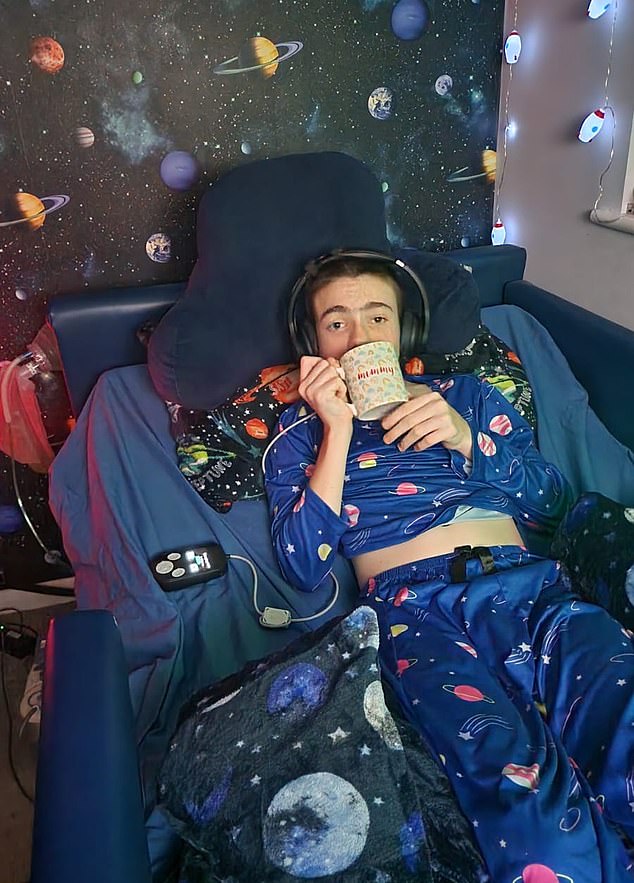British teenager becomes the first to receive a skull implant that controls severe epilepsy… reducing the number of daily seizures by 80 percent
A teenager with severe epilepsy has become the first patient in the world to have his seizures controlled by an implant in his skull.
Oran Knowlson has seen an 80 percent reduction in his daytime seizures thanks to the neurotransmitter that sends electrical signals deep into his brain.
The 13-year-old from Somerset has suffered from Lennox-Gastaut syndrome, a treatment-resistant form of epilepsy, since he was three.
He had daily seizures that in some cases caused him to fall to the ground, shake violently and lose consciousness.
But now eight months after his life-changing surgery as part of a trial at Great Ormand Street Hospital in London, the teenager’s future looks ‘hopeful’ and he is ‘more talkative’ and ‘involved’.
Oran Knowlson, 13, has seen his daytime seizures decrease by 80 percent as a result of the neurotransmitter sending electrical signals deep into his brain
Oran’s seizures started two weeks after his third birthday and until the trial he had not had a single day without a seizure.
After several seizures, he required emergency medication to revive him as he had stopped breathing.
Due to the severity of his epilepsy, he required 24-hour care for most of his life, as seizures could occur at any time of the day, and he was at significantly increased risk for Sudden Unexpected Death in Epilepsy (SUDEP).
‘Before the attacks started, Oran was reaching all its milestones, but as the attacks became more serious, we lost more and more to Oran. As a happy, energetic three-year-old, he struggled to participate in the world because of his medications and seizures – but he still has his sense of humor,” said Oran’s mother Justine Knowlson.
She added: ‘We’ve tried everything but this is the first real opportunity we’ve had in years, there was no ‘what next’ until now. Unless someone takes the first step in a lawsuit like this, there will never be a better one and there must be a better one for our family.”
Lennox-Gastaut syndrome affects about one or two in 100 children with epilepsy, which usually begins when a child is between three months and five years old.
The rare epilepsy syndrome regularly causes seizures and learning problems.
Oran is part of the CADET (Children’s Adaptive Deep Brain Stimulation for Epilepsy Trial) project, a series of studies assessing the safety and effectiveness of deep brain stimulation for severe epilepsy.
The partnership involves Great Ormond Street Hospital, University College London, King’s College Hospital and the University of Oxford.
Seizures are caused by abnormal bursts of electrical activity in the brain.
But the rechargeable device, the Picostim neurotransmitter, made by British company Amber Therapeutics, works by emitting a constant pulse of current to block these abnormal signals.
It is mounted on the skull and attached to electrodes deep in the brain to reduce seizure activity.
Oran had surgery to insert the device in October 2023 and once he recovered from the procedure it was ‘turned on’, delivering constant electrical stimulation to Oran’s brain. Since then, the lives of Oran and his family have changed completely.
Mrs Knowlson said: ‘We have been involved since December and we have seen a big improvement, the attacks have reduced and are less severe. That was great, but the improvement in quality of life has been invaluable to Oran.
‘He’s much more talkative and involved. He turned 13 and I’m definitely a teenager now – he likes to say no. But that contributes to his quality of life, when he can express himself better.
‘The team really supports you. We have never felt alone since last August (when we joined the lawsuit). We felt part of the team and so did Oran.
‘The future looks hopeful, which I wouldn’t have dared to say six months ago. For Oran, having hope brings excitement. It makes the future brighter and even more attainable. I am very happy that Oran can experience that.’
In Deep Brain Stimulation (DBS), a treatment that involves the insertion of a small device that stimulates specific parts of the brain, devices are mounted on the chest with wires that run through the neck to the brain.
But this device is mounted on the skull, which means the electrodes are less likely to break or erode as the child grows.

The device that can be charged via portable headphones (shown) works by emitting a constant current pulse to block these abnormal signals

Since receiving the implant, Oran has had a better quality of life and has become more talkative and engaged
It can also be charged via portable headphones, which can be used while watching a video or interacting with a tablet.
This also means that patients do not have to undergo surgery every three to five years to replace it.
The implant targets the thalamus, a junction for electrical signals in the brain.
It is hoped that the device will block electrical pathways and therefore prevent the spread of seizures.
It also features seizure pattern optimization settings, which, although not used in this study, could be used in the future for patients with Lennox-Gastaut syndrome.
‘Every day we see the life-threatening and life-limiting consequences of uncontrollable epilepsy. It can make school, hobbies or even watching a favorite TV show completely impossible,” says Martin Tisdall, pediatric neurosurgeon at GOSH and honorary associate professor at UCL.
‘For Oran and his family, epilepsy has completely changed their lives and it is absolutely amazing to see him riding and regaining his independence. We couldn’t be happier to be part of their journey.
‘Deep brain stimulation brings us closer than ever before to stopping seizures in patients who have very limited effective treatment options.
‘We are excited to build the evidence base to demonstrate the ability of deep brain stimulation to treat pediatric epilepsy and hope that this will be a standard treatment we can offer in the years to come.’
The CADET study is now recruiting three additional patients with Lennox-Gastaut syndrome for the pilot, which is funded by the Royal Academy of Engineering. 22 patients will then take part in the full trial, which is funded by GOSH Charity and LifeArc and sponsored by University College London.
